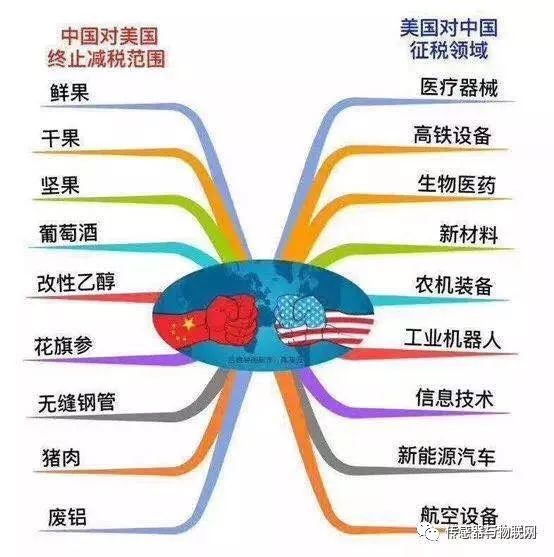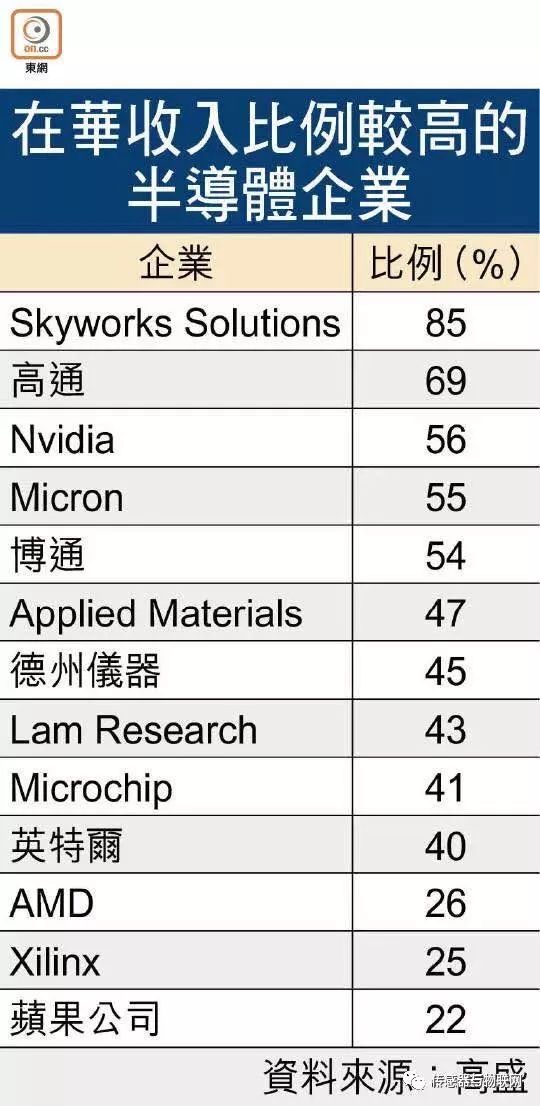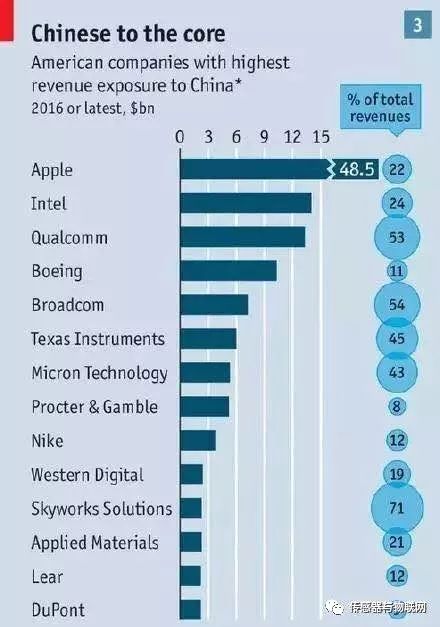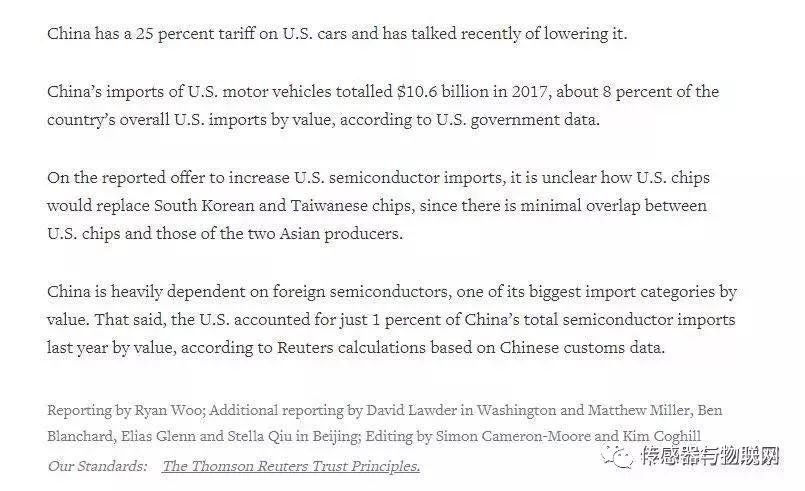The Sino-US trade war is in full swing! But it seems that the ending will be very helpless! In the early morning of March 23, Beijing time, US President Trump signed a memorandum, based on the "301 investigation" report issued by the US Trade Representative Office, instructing relevant departments to impose large-scale tariffs on imports of about 60 billion US dollars of goods from China. Restrict Chinese companies from investing in the United States. China countered this, the Ministry of Commerce issued a list of suspension concessions for the US import of steel and aluminum products 232 measures and sought public opinions, intending to impose tariffs on about $3 billion of products imported from the United States. And now the second wave is about to hit! First list of trade wars First, let's take a look at the first list of trade wars. Among the two commodity categories represented by agricultural products and seamless steel pipes, the proportion of US exports to China is actually relatively low, no more than 4%. The products that are particularly influential, such as automobiles, aircraft machinery, and electrical machinery, are the major products exported by the United States to China, and the proportion of exports to China is also high. Similarly, look at China's entire import product data in 2016: 40% is electronic machinery products and their parts and components, and other things such as agricultural products, chemicals, and raw materials are mostly around 10%. In the same year, nearly half of China's export products were electronic mechanical products and their parts, and nearly one-quarter of them were various light industrial products such as shoes and hats and toys. Some high-tech industries and products have not been included in China’s list of trade wars with the United States for two reasons. One is that the United States has originally restricted high-tech products exported to China; the other is that the United States has loosened its mouth and China. Access to imported high-tech products. The second and third batch of tariff list In addition, according to the latest news from the Oriental Daily News, following the announcement of the first suspension of the list of concessions, China is studying the second and third batches of lists, such as aircraft and chips. Trade expert Wei Jianguo said on the 24th that in the face of US restrictions on China, China is fully prepared, and China may follow up on US tariffs. Wang Hua, director of investment at Yifang Capital, said that it is widely believed that the Sino-US trade war will make Huawei and Apple a target, but there is little chance of a major impact on the company in the short term. Due to the complex structure of mobile phone components, Apple is an example. Its chip suppliers are from all over the world. Although there are mainland suppliers, there are also US suppliers. Huawei is biased towards manufacturing in China and temporarily supplies the supply chain to the two major mobile phone manufacturers. Less affected. It is said that the second wave of China’s trade counterattacks has hit US high-end semiconductor companies (such as chip makers) or the supply chain of mobile phone parts. More than half of Goldman’s 20 US companies list is a high-end semiconductor company or Technology companies that use parts and components, including Apple, Qualcomm, Intel, etc. Really affect semiconductors? There is a precedent for this form. At the beginning of Trump's appointment, in 2017, Bloomberg released a ranking of the highest-paid US companies in China in 2016. And stressed that if the trade war started, these semiconductor manufacturers will likely be greatly affected. Some media analysts believe that if China retaliates against this tariff, then Apple, Intel and other large international companies that are Dow and S&P 500 stocks may face difficulties because these companies have already started in the Chinese market. Engaged in business, and here is their main battlefield. From the data point of view, it seems to be common sense: In the most recent quarter, Apple’s $18 billion in revenue came from the Chinese market, accounting for 20% of the company’s total sales. At the same time, chip giant Intel -- and other semiconductor companies such as Texas Instruments, NVIDIA, Micron and Qualcomm -- also have larger operations in the Chinese market. Take Qualcomm as an example. In 2016, Qualcomm's annual revenue reached US$23.554 billion and net profit was US$5.705 billion. Among them, it is particularly noteworthy that nearly two-thirds of Qualcomm's revenue comes from the Chinese market. Charlie Dai, an analyst at Forest Research, told the Wall Street Journal that the Chinese business is increasingly strategically important to Qualcomm. The reason he gave is that the explosive growth of Chinese smartphones and the new business based on artificial intelligence require advanced chips. Mark Li, a technology industry analyst at research firm Bernstein, believes that as long as a company has a large amount of profits from China and has tangible benefits in the local market, then if the Chinese government takes action or the US-China trade friction escalates, It has an adverse impact on the company. But is this really the case? Readers who have an understanding of the semiconductor industry should understand the leading position of the United States in this industry. The overall backwardness of domestically produced chips will exist for a long time. It is basically impossible for China to pull chips into the trade warfare. It is even possible to kill five hundred and kill one thousand. For this reason, in our opinion, this may be a pretext. On the 23rd, SEMI Taiwan’s President Cao Shilun also attended the “Reporting Ceremony of the Signing Ceremony for the Implementation of the Smart Power Grid Commissioned Research Case†organized by the ASE Group. The trade war will have a more severe impact on the downstream products because of the product. Where the contents are printed, the situation affected will be relatively straightforward and will be relatively large. In the semiconductor industry, it is mostly because of the shutdown of components. Therefore, in the short term, the overall impact will be relatively small. Want to sell more chips to China? So what are the deeper goals of the United States in the trade war? According to the Wall Street Journal report, US Treasury Secretary Steven Mnuchin said in an exclusive interview with Flowserve News on March 25 that if China opens its market, it will be a huge opportunity for US companies. Menuchin said that he is cautiously optimistic about the agreement between the United States and China, but if there is no consensus, the United States will impose tariffs in accordance with the established plan. According to sources, Mei Nuqin is considering going to Beijing for trade negotiations. According to a letter from Meinuchin, US Trade Representative Office (USTR) trade representative Robert Lighthizer to Chinese Vice Premier and Chinese leader of the China-US Comprehensive Economic Dialogue, Liu He, the Trump administration hopes that China will lower its US cars. The import tariffs further loosened the participation of US companies in the local financial industry and transferred some of the semiconductor purchase orders originally intended for Japanese and South Korean companies to the United States. ( Originally: In a letter Messrs. Mnuchin and Lighthizer sent to Mr. Liu late last week, the Trump administration set out specific requests that include a reduction of Chinese tariffs on US automobiles, more Chinese purchases of US semiconductors and greater access to China's Financial sector by American companies, the people said. Mr. Mnuchin is weighing a trip to Beijing to pursue the negotiations, one of these people said.) However, according to Bloomberg News, the Financial Times quoted an unnamed source on Monday as saying that it was not the United States that made this request, but that China proposed to convert some of the semiconductors purchased from South Korea and Taiwan to the United States to reduce China’s trade surplus. Affected by this news, the US stock market Dow Jones index soared more than 600 points today, and semiconductor manufacturers such as Intel and ADI also rose more than 6%. Over-reliance, the semiconductor industry gives people a handle But whether it is China's initiative or the US pressure, this reflects the dependence of China's semiconductor industry on the outside world. The main reason is that the Sino-US industrial chain has different priorities and determines that the impact of the relevant industrial chain will be biased. According to Zhongcai.com, the United States is good at design and equipment in the field of integrated circuits, while China focuses on the back-end packaging and electronic manufacturing in the industry chain. Therefore, if measured by relevant import and export data, China's trade deficit with the United States is a large number of imported US chips and equipment, and the output surplus is the cost end of the finished chip (mainly sealed and manufactured). The US integrated circuit industry has a sound structure and a whole industry chain layout, which has absolute advantages in equipment and design. The integrated circuit industry is the pillar industry of the United States, and the United States deserves to be the center of the world's semiconductors. With the transformation of industrial structure and industrial transfer under the “flying geese modelâ€, the United States has gradually focused on the design and equipment fields, which are the most upstream of the semiconductor industry chain and have the advantage of bayonet. In fact, the fact that integrated circuits are in trade deficit is difficult to reverse in the short term. It reflects the "hard power" comparison between China and the United States on core assets. For the current Chinese semiconductor industry, when the industry chain can not be fully filled, the import of chips and equipment from the United States is a must, and the logic of domestic substitution can be fully realized in the short to medium term. The United States needs China's market dividends to maintain the company's operating profit and ultra-high R&D costs. To be precise, research and development that is out of the market cannot be maintained. In particular, on January 6, 2017, the US President’s Science and Technology Advisory Committee also emphasized in its report “Ensuring the Long-Term Leadership of the United States in the Semiconductor Field†that nearly 50% of China’s IC imports are currently from the United States. No matter which US semiconductor company, the Chinese market today cannot be ignored. Similarly, for the Chinese semiconductor industry, the import of chips and equipment from the United States is also determined by the current development. Domestic semiconductors urgently need development For foreign manufacturers, the outbreak of Sino-US trade wars will bring more or less negative impacts, both in terms of market acceptance and future development. But for China's semiconductor industry, which is looking for import substitution, it may be the biggest driving force. We must know that the core technology is subject to the crux of the fact that people are big and not strong in China's semiconductor industry. Therefore, the core of import substitution is: semiconductors, chips, components, automotive parts. Under the conditions of this trade dispute, these four sectors will receive strong support from domestic policies, and thus have the logic and basis for the configuration of medium and long-term lines. For a long time, the import volume of chips has occupied a high proportion. According to CSIA data, the demand for integrated circuit products in China reached 1.40 trillion yuan in 2017, while the domestic supply was only 541.13 billion yuan, and the self-sufficiency rate was only 38.7%. Circuit products rely on imports; in 2017, the import value of integrated circuit products reached 260.14 billion US dollars, which has replaced crude oil as the largest imported commodity in China. However, at the same time, the global semiconductor market reached 320 billion US dollars, 54% of the world's chips are exported to China, but the domestic chip market share only 10%. 77% of the world's mobile phones are made in China, but less than 3% of them are made in China. China's chip industry has long been controlled by foreign manufacturers, not only does it consume more than 200 billion US dollars in foreign exchange each year. Moreover, the technical equipment subject to people directly restricts the development of China's information industry. Research data shows that the chip industry's one-dollar output value can drive the information industry's output value of 10 dollars and 100 dollars of gross domestic product (GDP). Countries around the world have taken chips as a national key strategic industry. The United States, Europe, Japan and other developed countries have ensured technological leadership through a large number of R&D investments. South Korea, Singapore and Taiwan have promoted the rapid development of the IC industry through active industrial policies. Sino-US trade war is a protracted war The Sino-US trade war is a protracted war. Perhaps China's economic losses will be relatively large, but China has the most complete industrial system and the most powerful consumer market in the world, and the final victory will definitely belong to China. The United States wants to stifle the development of China's semiconductor industry. If it is changed 15 years ago, it can take advantage of China, but it is already late, and missed the best opportunity. As long as China is not in chaos, the rise is already inevitable. Perhaps the United States does not need to be particularly worried about trade retaliation, because the US exports of goods, in addition to large agricultural products are high-tech products, and now also increase oil and gas resources. Most of these commodities have rigid demand. In the United States, chips, software, and the Internet, other than China, there are no decent competitors in other countries. The trade war in the United States will gradually escalate, starting with basic industrial products such as steel and aluminum, and later to electrical products, automobiles, machinery and other products. However, industries that are productive but not competitive in the United States will gradually be included in the trade war. The scope. The trade war will also make China completely awakened. The economic transformation and the rejuvenation of science and technology are imperative, and will become the driving force for China's substantive reform. If the unicorn is more of a concept, many investors do not recognize that the market has objections and disagreements about semiconductors, then the trade war is more powerful than the unicorn. Why can Huawei mobile phones stand out because they have their own chips. It is not a matter of one or two days for a market to develop and even achieve self-sufficiency. This requires a long-term process. This trade war will often be encountered in this process, and even if there is no trade war, there will be other measures to limit us. Therefore, in the long run, chip companies with core capabilities will certainly benefit, and certainly a good development opportunity. But the result of this confrontation, the most injured may be Taiwan, Japan, South Korea and other regions of the manufacturers. Others Patent Vape,Air Bars Disposable,Disposable Vapor Pen,Disposable E-Cigarette Guangzhou Yunge Tianhong Electronic Technology Co., Ltd , https://www.e-cigarettesfactory.com



